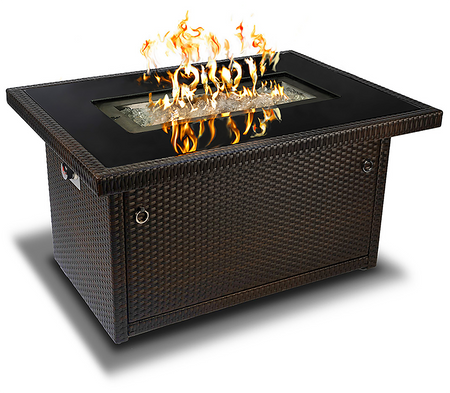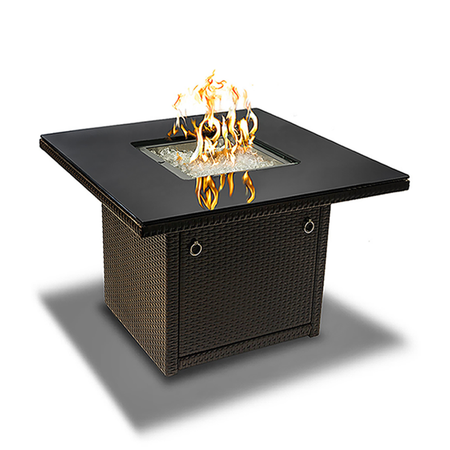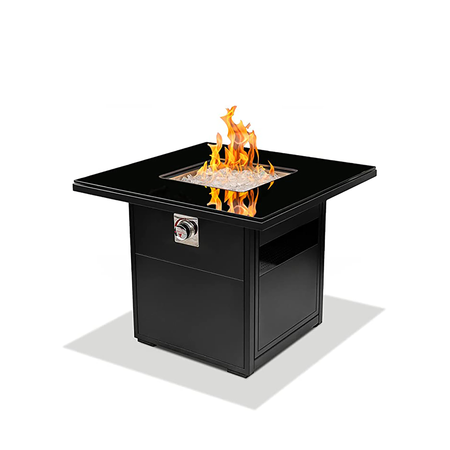Table of contents
Are you in search of a propane fire pit table to bring elegance and sophistication to your patio? A fire table is a wonderful way to transform your backyard environment, enhancing your ambiance and conveying a sense of luxury. But how do you choose a nice fire pit table?
Whether you are looking for a fire pit table propane-fueled or powered by natural gas, this guide will introduce you to key features that are important in a quality product. We will also discuss red flags to avoid, and answer some frequently asked questions. Let’s get started.

How to Choose a Propane Fire Table: Key Buying Considerations for Propane Fire Pit Tables
1. Dimensions
First, you will need to think about the location for your propane or gas fire pit table. Will it be on a wooden deck? A patio? How much square footage do you have to work with? What will your seating arrangement be? How flexible is that arrangement?
Fire tables come in a variety of sizes and shapes. Based on the dimensions and layout of your space, you can decide on a table that will fit your needs. Square and rectangular tables fit well in most environments, but you can also find round tables.
Don’t forget to think about height as well—you want the table to be at the right height for you to enjoy, especially if it includes a lid or cover so you can eat off of it.
If you are looking specifically for a patio fire table, see this guide.
Granville Fire Table
2. Construction and Materials
Many different materials are used to make fire tables. So whether you want a stone fire pit or a metal one, you can find options on the market to consider.
While stone fire pits can be attractive, they are too heavy and cumbersome for many users. Steel and aluminum frames, on the other hand, are durable and feature a lower overall product weight. Aluminum is the lighter of the two, but also the more expensive. Steel is a “best of all worlds” option. It is reasonably light, extremely durable, and resistant to rust with a high-quality protective coating.
Indeed, when choosing a fire table, you should make sure that the frame has an even coating with zero gaps. You also should check that the overall build is stable when you are moving it. That way, it will not be subjected to unnecessary wear and tear during the initial setup process, or later, if you need to relocate it.
Speaking of moving the fire table, it should be fast and easy to assemble, and you should be able to do so safely. That means that there should not be any protruding, sharp metal edges. The seams, pockets and corners must feature quality welding.
While you are checking out the frame of a fire table, do not forget to also make a close inspection of the gas components. Quality components will produce a beautiful flame profile, and quiet, long-lasting performance. Poor quality components will reduce longevity and make for a noisy, less attractive flame.
3. Propane or Natural Gas

Now, let’s talk about fuel type. Most fire tables use propane; you will be hard-pressed to find one that only uses natural gas. But some propane tables include a conversion kit if you would rather run a natural gas line than go with a fire table propane tank.
Propane gas burns cleaner, and you might not have a natural gas outlet. But there are good reasons to consider using natural gas as well. In fact, to explore those reasons in-depth, please see Choosing the Best Gas Fire Pit Table.
Granville Fire Table
4. Heat Output
The heat output for a fire table is expressed in BTU/HR. BTU is short for “British Thermal Unit.”
There is quite a wide range of BTU for fire tables on the market. On the lower end, you can find around 40,000 BTU, and on the upper end, around 150,000 BTU.
No option is really “better” or “worse” in a general sense. You will want to choose your heat output based on your specific needs.
A higher BTU will mean two things:
- Higher flames
- More heat
Now, here’s the thing. A fire table’s main purpose is to enhance ambiance. If your goal is to get warm or roast marshmallows, we suggest you go with a propane pit instead.
If you are at a high altitude, you might need a BTU as high as 70,000 BTU/HR. But in most locations, you don’t need more than 20,000-50,000 BTU/HR. The colder your climate is, the higher the BTU you need within that range.
We suggest not going with a really high BTU (i.e. 150,000), because the flames are harder to control, even with glass wind guards or other safety features. A wind guard can reduce the risk of burns or objects catching fire, but it makes more sense just to go with a lower BTU of heat for more control. Learn more about fire pit table safety.
Robson Fire Table
5. Ignition
Fire tables can come with different ignition systems as well, which is another important buying consideration.
Match light ignition systems are reliable and familiar, but many people these days prefer the convenience of an electronic ignition system.
A simple push-button system featuring auto spark ignition (piezo ignition) makes it a breeze to switch on your flames.
There is no chance of burning yourself with a match, nor do you have to worry about disposing of one afterwards.
6. Style

The next consideration we recommend paying attention to is the appearance of a fire table as well as the flame profile.
Most fire tables feature a modern, minimalist look, though there are some more rustic options on the market.
The profile of the flame should be appealing to the eye. A table with a glass surface adds the visual effect of attractive reflections.
The glass rocks that come with your fire table also can enhance its appearance. Depending on how many you use and how you arrange them, they can help you adjust the flame profile to your liking.
Yaletown Fire Table
7. Accessories
Finally, there are a few accessories that may come with your fire table. Look for a natural gas conversion kit if you prefer not to use propane. Also, see if you can find a product that includes a cover or lid—or better yet, both.
A cover for your fire table can increase its longevity by protecting it when you are not using it.
As for a lid, you can use that to convert your fire table into a fully functional tabletop. For those with small patios in particular, this space-saving feature can be a huge benefit, as it essentially turns your fire table into a two-in-one furnishing, eliminating the need to squeeze in a separate dining table.
Red Flags: What to Avoid When Choosing a Propane Fire Pit Table

You now know what to look for in a quality propane fire table. But what should you avoid? Here are some red flags to watch out for when comparing products:
• You do not need to spend an arm and a leg on a high-quality fire table. At the same time, you should be wary of a super cheap product, as the manufacturer may have cut corners.
• If you see protruding burrs or edges, a product may not be safe or well-manufactured. Also, look out for visible or damaged fastening staples on wicker products, or peeling wicker.
• High-quality powder coating on steel should not feel thin or “chalky.”
• Stainless steel burners and fasteners are best. Other materials may not be resistant to corrosion. Burner trays should not be powder-coated or galvanized, as either can lead to rust and toxic emissions. They also crack and peel, and do not last long.
• A loose or inaccessible propane tank ring will cause issues.
• Watch out for products that don’t offer substantial, high-quality heat shielding between the burn tray and propane tank.
Granville Fire Table
What Makes Outland Living Fire Tables the Best?
Outland Living’s line of fire tables includes rectangular and square propane tables with weights ranging from 83 to 96 pounds and BTU/HR ranging from 42,500 to 50,000. All tables feature auto ignition and come with an Arctic Ice Glass Rock Set. You can convert any of them for use with natural gas by purchasing an optional kit.
Our fire tables include high-quality parts and materials such as stainless steel burner pans, tempered glass tabletops, and hand-woven resin wicker. While Outland Living propane fire tables are more cost-effective than those of many of our competitors, we put great attention to detail into every aspect of design and construction.
For example, a lot of manufacturers punch screw-size holes into thin steel parts and may not even tap threads into the steel, so the screws tend to work themselves loose. By contrast, we use hex head rivet nuts at all customer assembly points. Our tables are TIG-and MIG-welded with straight, consistent seams.
Quality checks are performed on each and every Outland Living fire table. Moreover, all of our tables are CSA-certified, which means that they are safe to use in clear weather or in rainy or windy conditions.
Conclusion
Now you know what factors to consider when you are choosing a propane fire pit table. Moreover, you know how to assess quality and avoid inferior products. Check out our selection of fire tables, or continue exploring our blog to learn more about fire tables, fire pits, and more.







